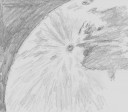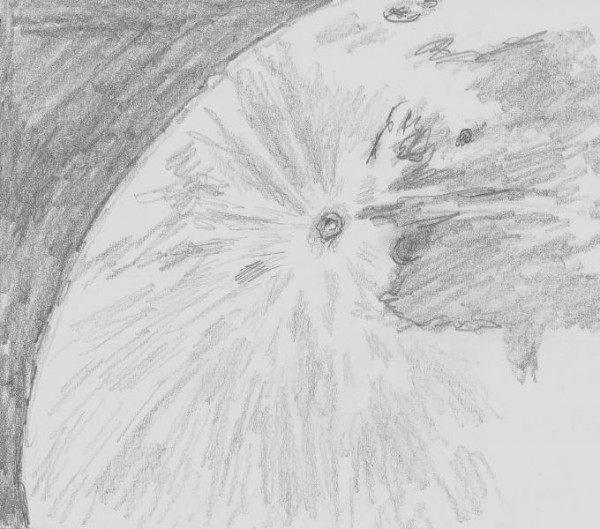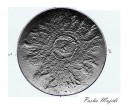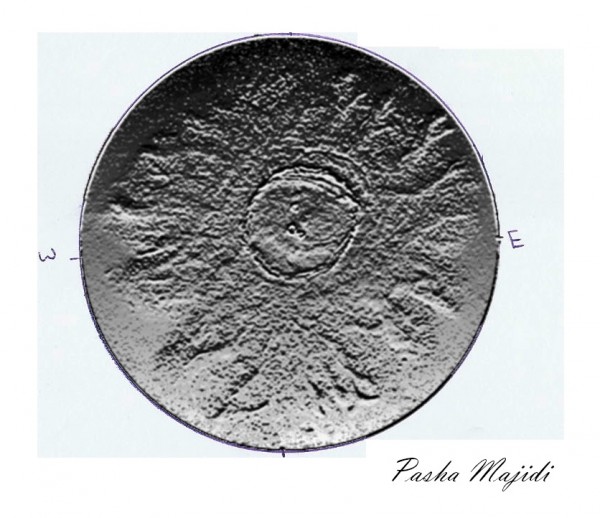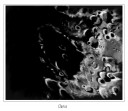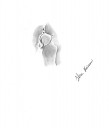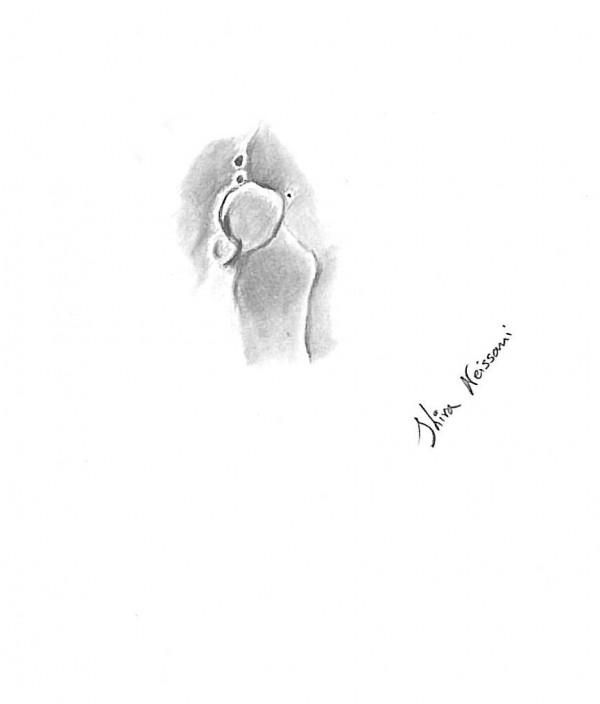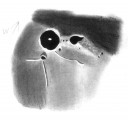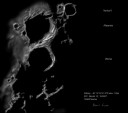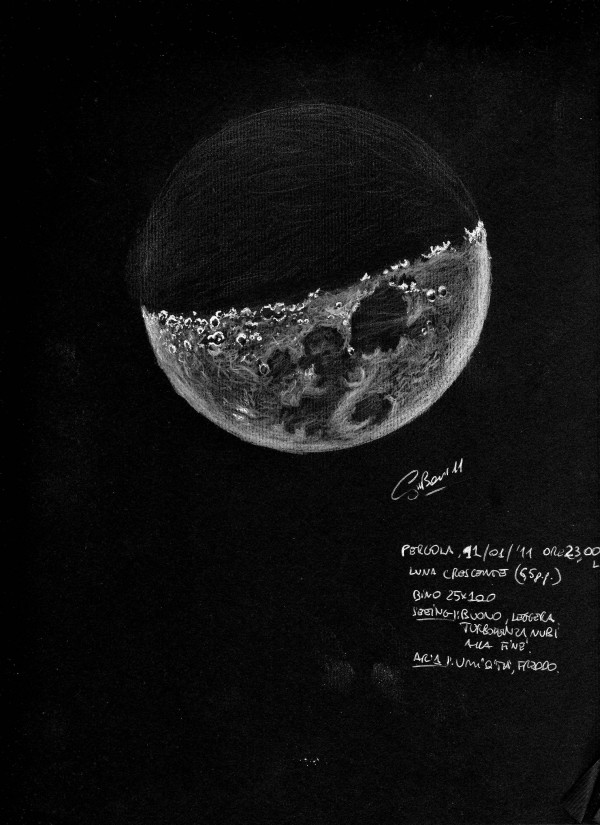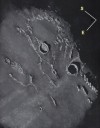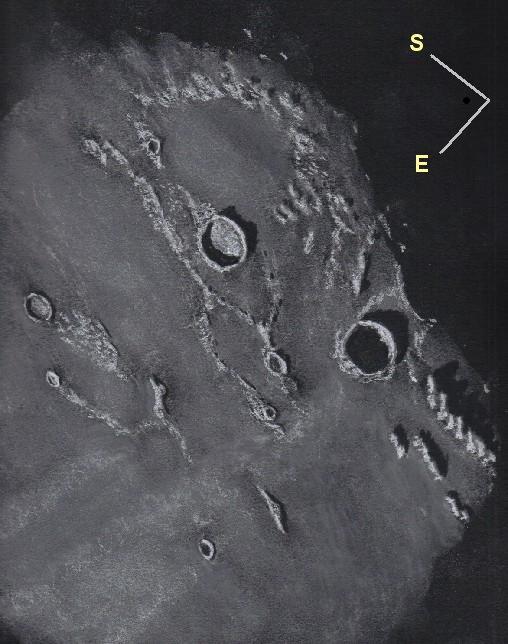Object Name: Moon Craters Letronne and Gassendi
Object Type: Lunar craters
Location: Pittsburgh, PA, USA
Date: 1979-May-8
Media: graphite pencils on plain white paper; scanned to jpeg as original.
Equipment Used: 4.25 inch Newtonian; 192x
Observing Conditions: fair, calm
Aspects of Interests: The submerged wall of Letronne is very interesting, especially as a contrast to the steep walled crater Gassendi. Gassendi A and B are the small craters infringing on Gassendi’s North wall. Very dark in the middle suggests that they are deep and possibly young. Well defined details on all these objects except the walls of Mare Humorum to the South seen as very flat and without detail except at its Western edge where Gassendi lies across it. The area is mapped as Rima Mersenius. Illuminated walls are very bright. The maria are a very pale grey. I think Rima Herigonius is the bright light with distinct dark edge to the East of the group.
Thank you,
Jim Garasich
Category: Moon
Ten Minute Tycho
Object name: Lunar crater Tycho and rays
Object Type: Lunar crater, rays
Location: York, UK
Date: 18th March 2011
Time: 20.30-20.40 UT
Media: graphite pencil, white paper
Instrument: Skywatcher Skyliner 152mm f8 Dobsonian, 25mm e.p.
As I took in the beauty of the full moon at perigee, I noticed a small black object zip across the face of the moon. I thought I’d probably seen a satellite, but, a minute or two later I saw another one, and then another one, and then another, and they were definitely birds. They were all travelling in the same direction: North. After waiting about half an hour and seeing about twenty of them, and trying to take in the jizz of the form, the best I could do was narrow them down to swallows and martins. Do they migrate at night? Well, if so, this was a unique way to see my first hirundines of the year.
Seeing was very wobbly, preventing me from using high powers on the scope, so I eased back into low power and sketched the crater Tycho and its rays, which you can also see with the naked eye as they splat half way across the face of the full moon. I like sketching fast; it forces me to find the key features first. Tycho itself is not huge as lunar craters go, but it’s visible because it’s young and its rays have not yet eroded away. It’s estimated to be about 100 million years old which means that some dinosaurs and mammals probably saw it hit; it must have been spectacular.
The crater is named after Tycho Brahe, one of my heros. His accurate measurements of the stars and planets led to the later discovery, by Kepler, that the planets move in elliptical orbits around the sun, which in turn is the basis of universal gravitation. It’s not an exaggeration to say that Tycho paved the way for our modern understanding of the universe. And he has a rather beautiful crater named after him too.
One of the things that I spotted for the first time was that there are fewer bright rays pointing west (top in the picture), suggesting that the impactor that formed Tycho came in from that direction.
Crater Pythagoras at the End of Winter
On this last evening of winter just hours before the full Moon, my sky cleared enough to get out and sketch the Moon.
130 km. crater Pythagoras was well positioned on this evening for lunar sketching. Before the summer of 2009-laser altimeter reading taken by the Kaguya gave a crater depth of 4.5 km. with central peaks rising to 3 km. above the crater floor. At 130 km. in diameter, the terraced walls of the distant rim were nicely visible in moments of good seeing. Hugging the southeastern wall of Pythagoras, slightly larger Babbage (140 km.) with its old crumbled walls and large central crater Babbage A shared the spotlight here near the dark lavas of Mare Frigoris. If you follow the west wall of Babbage to the south, you arrive at 70 km. crater Oenopides with its shallow featureless floor.
Sketching Information
Pythagoras Crater on black 400 Series Strathmore paper using white and black Conte’ pastel pencils
Sketch Date: March 19, 2011, a time of favorable libration for this crater using a 13.1-inch f/6 Dobsonian telescope riding on an equatorial platform with a 6mm eyepiece for 333x at 05:05-07:00 UT
Seeing: Antoniadi III
Weather clear, calm, 32 degrees F (0 degrees C)
Lunation 14.3 days
Moon 99.6% illuminated
Colongitude 83.9°
Latitude Libration +07° 06′
Lunar Distance: Near Perigee
Rükl Atlas Pl 2
Frank McCabe
The Crater King
Dear artists Hi:
last night, my brother asked me to find an image of Copernicus for
his thesis, I had found one of my first sketches from Moon for him…
Can you imagine what happened when he saw this Sketch?
Note: a little edited with Photoshop.( light angle)
Object name: Copernicus crater/Moon
location: Iran/Tehran
13.Feb.2011
Optic: Tel. Skywatcher( 8”.Dabson.)
Eyepiece: 10 mm multi coated
Media: Pastel/ Black pencil/Chalk and Charcoal/White Paper
Moon Phase: Full Moon
Seeing : Fairly Clean
Clear Sky.
Pasha Majidi
Clavius out of the shadows
Clavius
Lunar crater
Hartlepool, UK
14th March 2011
Drawn digitally using pencils, chalk and blenders.
I drew this at the eyepiece of my 10 inch Newtonian a with a magnification of x375 using regular pencils then redrew it indoors on the computer digitally.
Apart from the important stuff like the positioning and shape of the main craters the next thing I think is the tone of the surrounding area, trying to match the lights and darks but of course trying to simplify what you see.
On the Eastern Shores of Serenity
Filled with Lunar Night
Hello!
Here is a sketch from me. I drew it few weeks ago
with my little (2″) telescope at a windy night.
I hope you’ll like it.
And here are some data:
Object Name: Theophilus Crater
Object Type: Lunar Crater
Location: Érd, Hungary
Date: 2011/02/08
Media: (graphite pencil, white paper)
I wish you a lot of clear sky
Beautiful Highland
The data of the drawing: Nonius K – Aliacensis – Werner crater
10.02.2011.
Telescope: 3″ F/11 Newton and 7,5 mm Super Plossl eyepiece
Observing Location: Zakany – Hungary, 46° 15′ N 16° 57’E elev.: 129m
This digital drawing preparated GIMP 2.6 programs.
Thank you for it!
Clear Sky !
Tamas Bognar
http://tamasasztro.tk
skype : bognartamas
msn : bognart@gmail.com
The Crescent Moon and Crater Delambre & Taylor’s Environs
Hello Artists,how are you ? I’m o.k. at moment,only aches of season,cough and cold.Two weeks ago the Moon was splendid over my head crescent phase and i take my Newton 6″ f 5 . I have placed my scope in front of my home and i start my draw.
Splendid vision the image was still, decide for zone at South(North in Newton) of crater Julius Cesar and Ariadeus Rhyme.
The zone was full of craters,different dimension, very difficult to draw,at the end turbulence and clouds oblige me to stop….The second sketch was a simply drawn on black paper and white pencil and pen made with my big bino 25×100 in front of my home.
I hope you like it.
One particular greetings at Master Frank, Richard Handy and Deirdre Kellegan and all great astro artists.
Ciao a tutti, Giorgio.
Site:Pergola,Marche Region,Center Italy,265 m. o.l.s.
Date:9 February 2011 from 9,30 p.m. to 10,49 p.m. local time.
Instrument: Newton 6″ Meade f.5
Eyepiece:12,4 mm Meade “Reserch Grade” and Barlow 2x
The crater is: Delambre (great at left),Theon Senior ( at low under Delambre),Theon Junior (up ),Taylor (at high center),Taylor A and B ( at center nearly).
Seeing:Good at start,turbulence and clouds from second half of sketch (interrupted ).
Temperature:Cold,many humidity at low
Craters Kepler and Enke
Craters Kepler and Encke At nearly 11 days into the current lunation sunrise has just finished for the rim of crater Kepler. Even during this early morning view, some of the brightest rays of this crater were seen radiating eastward from the ramparts on that side. Kepler is a 31 kilometer diameter complex crater with a low central peak and a flat debris covered floor from inner wall slumping. As I saw it during the time of this sketch, the floor was in complete darkness and had the perception of great depth. Crater Kepler lies between the Oceanus Procellarum and the Mare Insularum both of which consist of dark surface lavas.
The Jesuit astronomer Giovanni Battista Riccioli named Crater Kepler about 28 years after the death of Johannes Kepler. He also named Crater Tycho after Tycho Brahe, the man with the accurate data measurements that helped make Kepler famous for his three laws of planetary motion.
I was hoping to include Rima Milichius in this sketch but the seeing was so poor I never saw a hint of it even at its widest part that would have been located in the lower left corner of the sketch. The other crater captured in this sketch is 1 kilometer smaller in diameter and 3 times older than Kepler. This is crater Encke named after 19th century German astronomer Johann Franz Encke. The rubble-covered floor of this crater was well illuminated because of its greater distance from the terminator and much shallower depth.
Sketching and Equipment:
For this sketch, I used black Strathmore 400 Artagain paper 9” x 12”, white and
black Conte’ pastel pencils and blending stumps.
Telesccope: 13.1 inch f/6 Dobsonian and 9 mm eyepiece (222x) riding on an equatorial platform
Date: 2-14-2011, 00:30-02:00 UT
Temperature: 4° C (40° F)
Partly cloudy, very windy
Seeing: Very poor – Antoniadi IV-V
Colongitude 39.8 °
Lunation 10.9 days
Illumination 96.7 %
Frank McCabe


